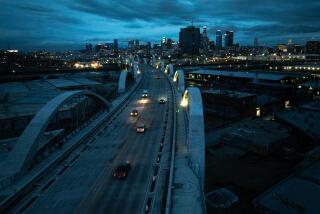Maine Drawbridge Gets Icy Reception
- Share via
PORTLAND, Maine — The Casco Bay Bridge linking Portland and South Portland boasts a sophisticated computer system that operates one of the largest drawbridge spans in North America.
It’s great when it works, but its failings have earned it the nickname “bridge from hell” from Portland’s police chief.
More than 18 months after the $130-million bridge opened, it’s still going through what some call “growing pains.” Those who are inconvenienced when the drawbridge gets stuck just call it a pain.
“I think it’s a disaster for people who use the bridge going in either direction,” said Chief Michael Chitwood. “Certainly the span was built to enhance the flow of traffic and to make river traffic more conducive. But it’s been a nightmare.”
The problem is that the bridge, which relies on computers and hundreds of sensors, can’t handle Maine’s tough winter weather.
Too much wind or ice means the traffic gates won’t work. Bitter cold causes the drawbridge’s lubricants to congeal, stopping the spans in their tracks while traffic backs up in both directions. Corrosion from road salt and sand causes sensors to malfunction.
Modjeski & Masters Inc., the Pennsylvania bridge designer, has built similar spans but none exactly like the “state of the art” Casco Bay Bridge, said Eugene Waldner, senior vice president.
Waldner described the operational problems as “relatively minor,” affecting about 2% of the bridge openings. “I do not believe there is an inherent design problem,” he said.
The state Department of Transportation is happy overall but acknowledges problems are not “relatively minor” for those affected.
Tom Doe, construction engineer for the Maine Department of Transportation, said the bridge delays and unplanned closures are “super unacceptable” for motorists and ship captains.
“What we need to do is get ourselves into a situation with 100% reliability,” he said.
Since the drawbridge opened with fireworks in August 1997, there have been more than 20 instances when it has failed, including three in January alone, said Everett Barnard, bridge maintenance engineer for the DOT.
There is little recourse for angry motorists other than to wait it out. There is no way to turn around, as there was with the old bridge.
It’s the same for tanker captains and tugboat operators, who have had to put on the brakes to avoid crashing into the drawbridge when the spans failed to lift. They must either anchor or reverse because there is no room for large vessels to turn around in the Fore River.
The longest the drawbridge was out of commission was for three days last March because of electrical problems, Barnard said. The 32,000 motorists who use the span each day had to find another route.
The Coast Guard has urged tanker pilots and tugboat operators to call the bridge early to make sure the spans go up, frustrating motorists who must wait longer for the ship to pass through.
Coast Guard Ensign Wade Gough said it’s better for motorists to have to wait a little longer than to have another accident like the one involving the Julie N, a tanker that smashed into the old bridge in 1996, spilling 180,000 gallons of oil into Portland Harbor.
The old bridge, built in 1916, was demolished to make way for its successor. The new bridge does not have to raise its spans--230 feet in the air--for ships that are under 65 feet tall at mean tide. That height means it opens less frequently than the old bridge. But the wait is longer: about 14 minutes instead of 9 minutes.
Portland and South Portland have installed blinking signs to warn motorists when the bridge is up so they have the option of taking an alternate route. That has helped.
Despite the problems, it’s not all doom and gloom, Barnard said.
When the bridge works--which it does most of the time--it is a smooth, quiet process, he said. And most important, the new bridge is safer for ships because the thoroughfare, at 196 feet, is twice as wide as the old bridge, with which tankers had only inches of clearance when they passed underneath.
The old bridge ran manually and did not have the safety elements of the new mile-long bridge, said Ralph Knight, who has raised the drawbridge on the Fore River for more than 25 years. Now when the bridge goes up and down it’s a flick of a switch, and the sensors do all the work.
The six-foot control panel in the bridge house lights up with red, green and yellow lights, and bridge operators, like Knight, oversee the event to make sure it goes as planned.
“In all fairness, it’s an extremely complex structure,” Barnard said. “It looks simple, but if you go into the [control] building it’s extremely complex, and I think with all the parts we’ve got there, we are fortunate to have these small problems instead of big problems.”
Knight said people need to work together to make things go smoothly on the new bridge. He said that includes motorists, who should enjoy the quiet interlude that the raised spans afford them.
“We’re living in an instant society--instant coffee and instant tea and everything is snap, snap, snap! We all need to slow down,” he said.
More to Read
Sign up for Essential California
The most important California stories and recommendations in your inbox every morning.
You may occasionally receive promotional content from the Los Angeles Times.













